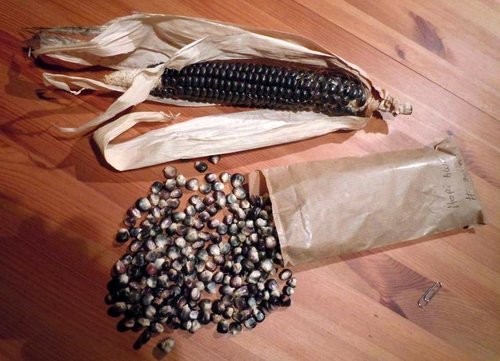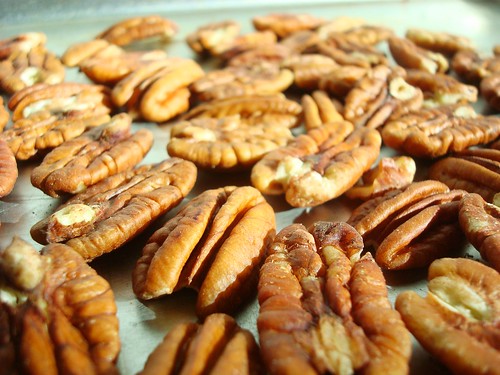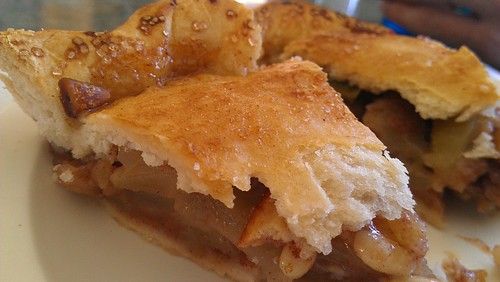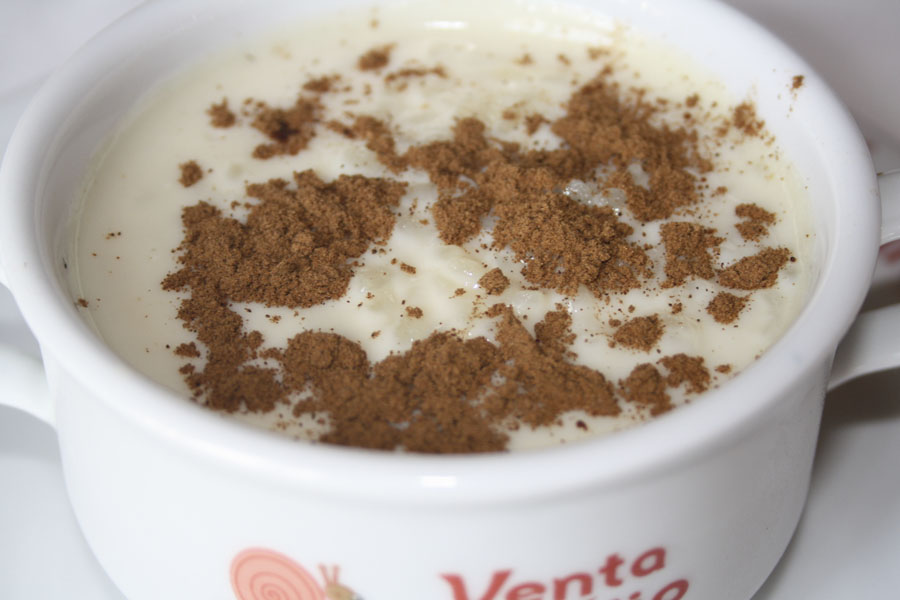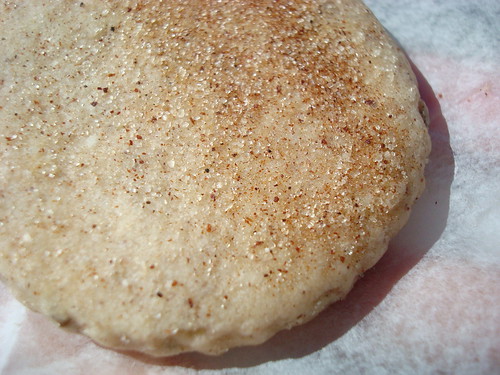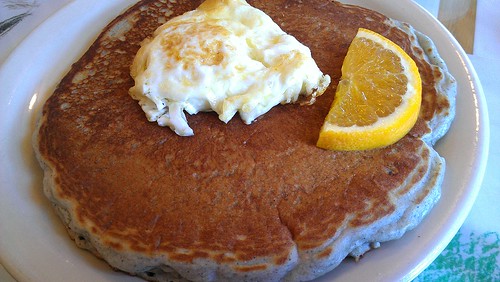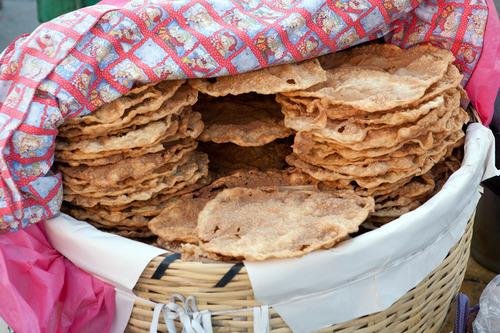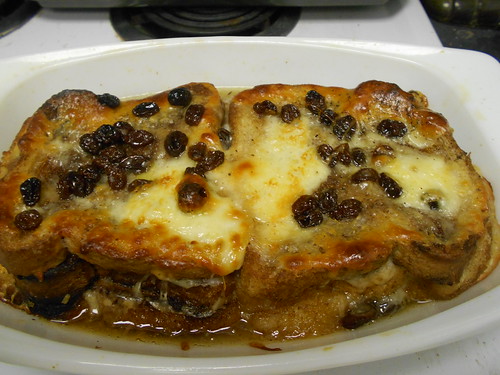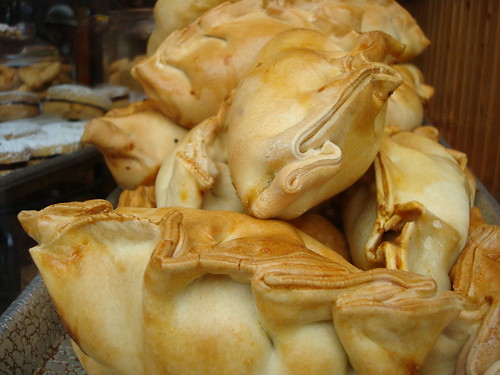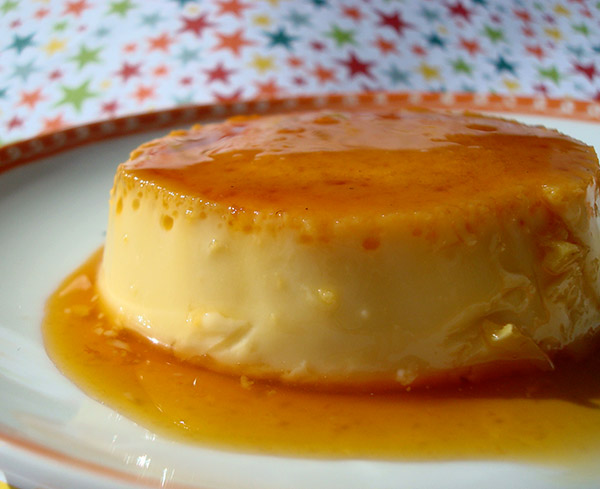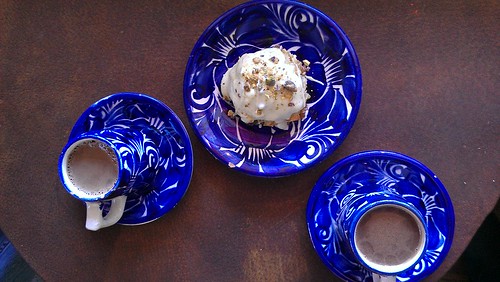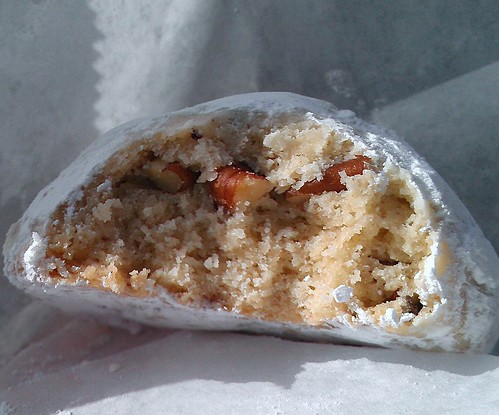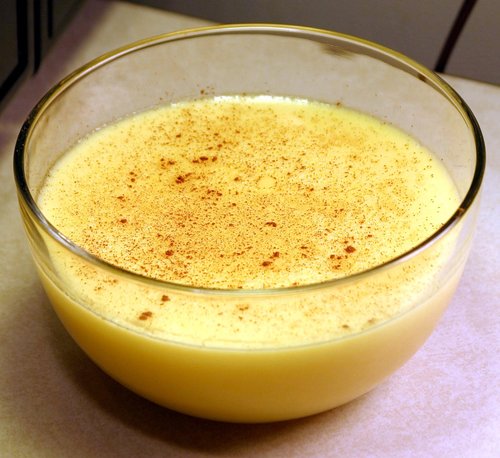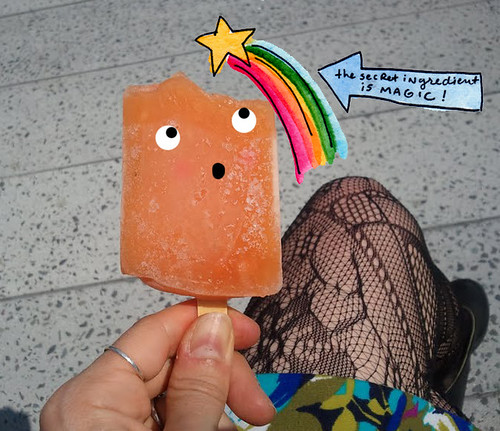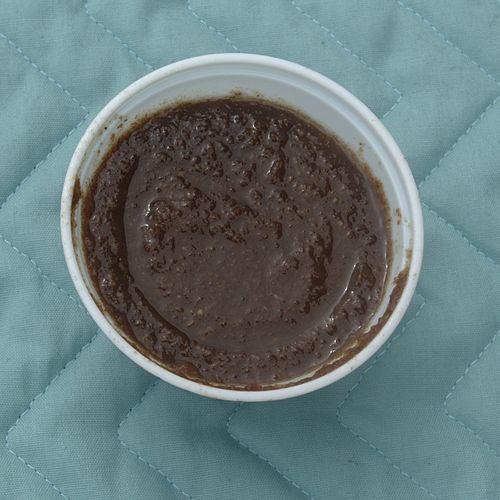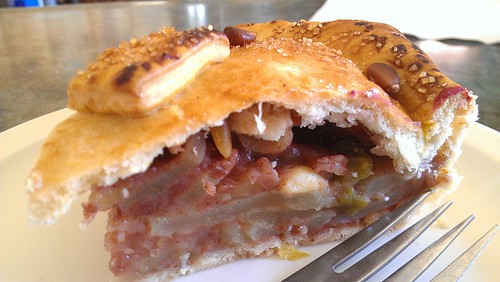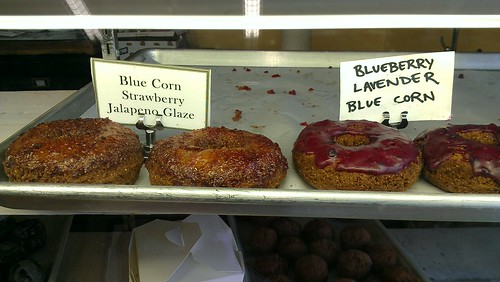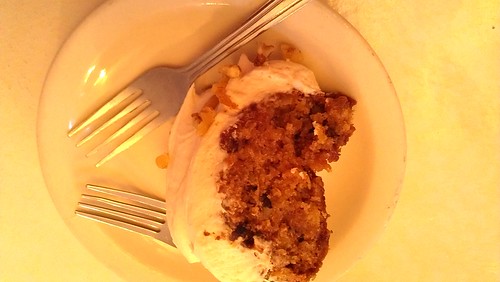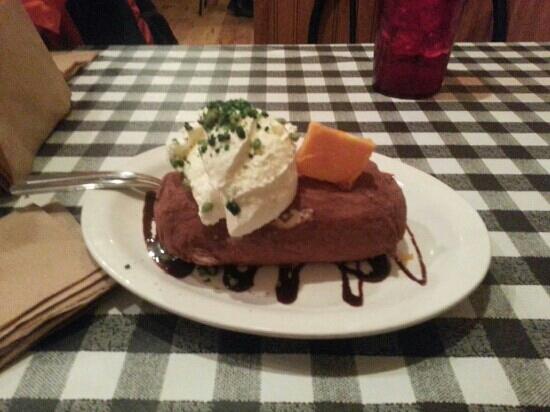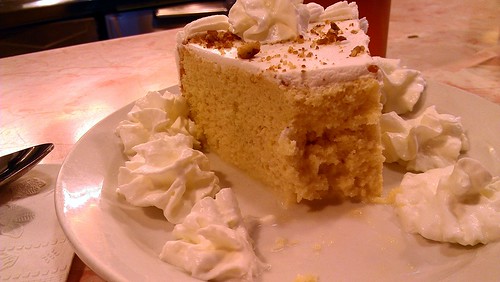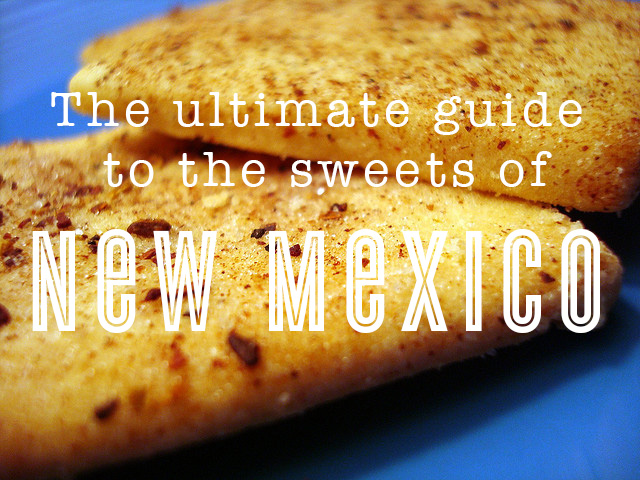 In case you didn’t know it, I’ve been spending quite a bit of time in New Mexico since last year. I didn’t know much about New Mexico before I came aside from the fact that it was, in fact, in the USA (apparently a leg up on some other US residents who don’t even know that!). One of the most impressive things to me about New Mexico is not its dramatic sunsets or majestic mountains or even the fact that it’s where that sandy desert Boyz II Men Video was filmed, but its unique desserts. I thought it would be interesting to give you an in-depth look at the desserts of the “land of enchantment”, including a little cultural context and a look at the ingredients which are commonly used in dessert here.
In case you didn’t know it, I’ve been spending quite a bit of time in New Mexico since last year. I didn’t know much about New Mexico before I came aside from the fact that it was, in fact, in the USA (apparently a leg up on some other US residents who don’t even know that!). One of the most impressive things to me about New Mexico is not its dramatic sunsets or majestic mountains or even the fact that it’s where that sandy desert Boyz II Men Video was filmed, but its unique desserts. I thought it would be interesting to give you an in-depth look at the desserts of the “land of enchantment”, including a little cultural context and a look at the ingredients which are commonly used in dessert here.

New Mexico: a brief culinary background
Many believe that the dramatic, sweeping sunsets and ruggedly beautiful landscape of New Mexico, which has inspired artists for centuries, is the reason behind the state motto “the land of enchantment”. Not to put down Georgia O’Keeffe and company, but I do respectfully submit that the cuisine is equal if not greater in terms of enchantment level.
New Mexico’s sun-baked soil and chilly desert nights provide a unique growing climate. While many crops are grown in the state, the short growing season, dry climate, and temperature variances lead to extremely concentrated flavors. Whether it’s a red-hot chile or a supersweet apple, the flavors are alive.
The colorful and zesty nature of the cuisine is certainly evident in its enchiladas and famous green chile cheeseburgers, but it carries over to the dessert course, too. They’re not afraid to embrace flavor in their dessert: let’s say New Mexico was doing chile-infused chocolates way before it was trendy.
What you have in New Mexico is a unique mash-up of cultural cuisines. Initially settled by Native Americans, colonized by the Spanish, home to many Northern seeking Mexicans, and now home to many aging hippies. Each contingent has made distinct contributions to the cuisine of the area, which shows traces of each of the aforementioned sources but is not quite any of them--New Mexican cuisine is a thing all its own. This is true of the desserts, too. Gluten-free wild blue corn pudding with Mexican spices? It wouldn’t be unheard-of.
It’s important to remember that the Native Americans were there first, and the mentality of using what the earth provides still certainly pervades the culture, including that of dessert. Early sweets would be likely to employ ingredients that were simply there: eggs, corn, honey, lard, spices, and milk--in the earliest days, goat milk, but as the industrial revolution came about, dairy from cows, too.
The influence of the Spanish and Mediterranean explorers added cooking methods and ingredients that would not have been around otherwise, making for a fusion of Spanish recipes with native ingredients: that’s where we get such dishes as bunuelos, biscochitos, and natillas.
As a side note on Native American sweets, this is one of the most difficult parts of the dessert scene to pinpoint, as many of these treats are baked at home rather than as offerings in a commercial setting. I did my best, as you will see below.
Some of the cuisine in New Mexico can be confused with the food of Mexico, because both can tend to earthy and rich in flavor. In New Mexico, the cuisine is particularly chile reverent, and the fiery pods are used even in desserts such as New Mexican apple pie with green chile or brownies scented with red chile.
Since the 1900s, New Mexico has been a hamlet for artists of all types. This has brought an air of sophistication to the state’s dining, which has over the years led to city and hipster type interpretations using locally harvested ingredients. Trendy doughnut shops featuring blue corn and chile on their (gluten free) holey treats? Hey, it could happen.
Key ingredients
Here’s a look at some of the key ingredients which are used in New Mexico sweets. Not all of the ingredients are exclusive to the area, but you’re very likely to see them play a role in the sweets of the region. They can also give a deeper look at the way ingredients may play into desserts, giving a local flavor to even desserts or sweets such as cookies, cakes, or doughnuts. For instance, a doughnut is not a regional treat in New Mexico, but a blue corn doughnut could be unique to the area.
Blue Corn
Blue corn? Yep. This is a variety of maize which is grown in New Mexico. Mild, nutty, and lightly sweet in flavor, perhaps its most distinguishing characteristic is its color, which is indeed an indigo hue. The cornmeal is a frequent part of sweet recipes, making its presence known in quick breads, doughnuts, pancakes, and bundt cakes.
Chile
To say that chile is a vital part of New Mexican cuisine would be an understatement. Beyond condiment, chiles are sold directly from roasters on the side of the road, and are present in just about every meal. The big question is red or green? Or “christmas” - both? They are added to desserts too, including Pumpkin Green Chile pie, Red Chile Brownies, and a famous apple pie with green chile.
Cinnamon
The importance of cinnamon in New Mexico desserts cannot be underestimated. It is the dash of something that makes natillas sing; it is the extra spice that makes biscochitos warm and fuzzy in your mouth.
Chocolate
Everyone knows that Spanish explorers loved drinking chocolate (at least, that was an interesting tidbit I remembered from History class). Chocolate remains a rich tradition in the area, with traditional drinking chocolates readily available and a wide variety of locally made chocolate available. In Santa Fe, there’s even a self guided “chocolate trail” including a number of fine local purveyors.
Dairy
One of the state’s largest sources of income is through its dairy products. This translates into the dessert arena, where many dairy-rich desserts can be found regularly at restaurants. It wouldn’t be New Mexico without flan or tres leches cake (or both) on the menu.
Piñon
You may call it a pine nut, but in New Mexico, this is not reserved as an ingredient for pesto. It’s a way of life, with the scent of piñon roasting a part of the landscape and street vendors advertising the new batch. Though fairly expensive as an ingredient, it’s not unlikely to see it used in desserts, such as chocolates, pancakes, or ice cream.
Peanuts
The conditions for growing Valencia peanuts--characterized by three or more small kernels to a pod and a bright red skin--are a small, sweet peanut which can be roasted or boiled. If the baker is using local ingredients, these unique peanuts contribute a slightly different peanutty flavor in New Mexican sweets.
Pecans
Although we usually will think of Louisiana when we think Pecans, it’s one of New Mexico’s top agricultural crops. This makes pecan based desserts a stronghold, whether it’s a rich pecan pie, pecan-studded cookies, or a rich caramel turtle chocolate cake.
Piloncillo
This is a type of unrefined cane sugar which resembles brown sugar in color, but has more similarity flavor-wise to palm sugar. It is purchased as a cone, which can be shaved or cut.
Pistachio
Grown in the desert, pistachios are actually one of New Mexico’s top harvests. Though a popular ingredient globally in dessert, its presence is prominent in New Mexico desserts, from lemon pistachio white chocolate doughnuts to delicious and unique pistachio brittles.
Prickly Pear
Nicknamed “indian fig”, the prickly pear is the sweet-tart reddish fruit from a cactus which grows in the dry areas of the southwest (prominently in New Mexico and Arizona). It is a key ingredient in imbibements such as margaritas, as well as in dessert course treats such as sorbets, ice creams, and sauces.
Sweet Specialties of New Mexico
These are the treats you’ll see often enough to take notice in New Mexico. Some are unique to the area, and others simply proliferate in a big enough way to bear mention.
Apple pie with green chile
In New England, there is a saying that “apple pie without the cheese is like a kiss without the squeeze.” In New Mexico, it’s green chile that adds a little spice to the life of apple pie. It’s a commonly seen specialty in restaurants and cafes, and a recipe has even been shared in the Smithsonian.
Arroz dulce or Arroz con leche
You’ll recognize this dish if you see it: it’s rice pudding. The version favored in New Mexico has a distinctly Mexican inspired flavor; it’s almost like the pudding version of horchata. It’s made with milk, sometimes raisins, and always spiced with cinnamon.
Atole
Corn is the base of this traditional beverage of Mexico and Central America. Corn flour is combined over heat with water, piloncillo, cinnamon, vanilla and optional chocolate or fruit to make an earthy, hot beverage which is commonly served as an accompaniment to tamales during the holiday season.
Biscochitos
As the Official State Cookie of New Mexico, this delicately flaky anise-scented cookie demands civic respect. There are variations on the recipe: sometimes they’re made as circles, sometimes as diamonds, sometimes trefoils. The spelling is sometimes of debate, too: you’ll see them as biscochito or bizcochito (see lore, below). But most old-school bakers will agree on at least one thing: the secret to the melt-in-your-mouth texture, which simply cannot be substituted without sacrificing authenticity, is lard.
Blue corn pancakes
Using blue corn in pancakes is a trend which is generally credited to Tecolote Cafe, whose atole pinon pancakes have been featured on the Food Network and beyond. It has spread far and wide, though, and is a frequent occurrence on breakfast menus.
Buñuelos
These lightly sweetened doughnut-esque fried bits of dough are not unique to New Mexico; you’ll find variations of them as widely flung as the Dominican Republic, Puerto Rico, and Mexico. In New Mexico, you’ll often see a version which seems like a relative of the sopaipilla; the terms are sometimes used interchangeably. They are typically sweetened with sugar and cinnamon; sometimes, a sugar cane glaze is employed for maximum deliciousness.
Capirotada
Photo via Flickr member Joel Kramer
This variation of bread pudding is characterized by its addition of cheese and spices--a cinnamon-rich mixture which makes it sort of like bread pudding meets cheesecake with a dash of horchata. There’s no part of the equation that is wrong.
Chile chocolate
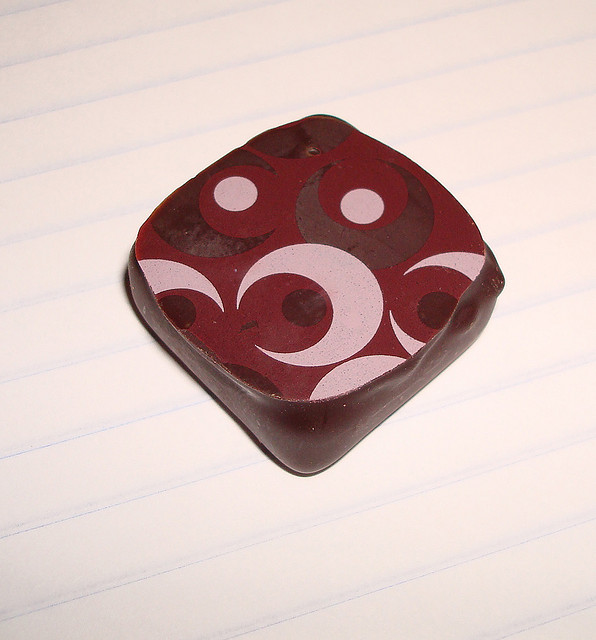
Chocolates scented with chile are an everyday occurrence in New Mexico. All chocolate shops will stock some variation on the theme, whether it’s straight-up dark chocolate with ancho chile or a more involved confection with pinon, caramel, and chile. Brownies will also commonly contain chile.
Chongos
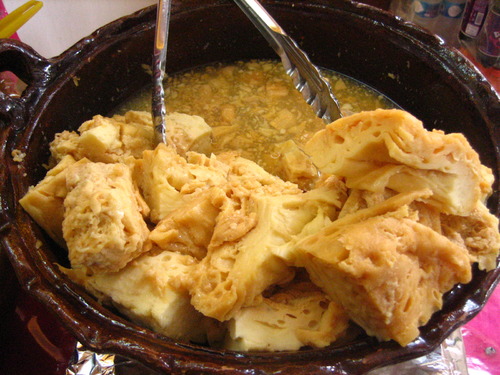 Chongos photo via Wikipedia Commons
Chongos photo via Wikipedia Commons
Apparently “chongo” is a Spanish term used similarly to the term “chignon” which is referred to a particular twist of women’s hair. Certainly there is a twist involved in the dessert, which is made with cheese curds which are “twisted” and served with a sweet syrup.
Dulce de calabaza
Pumpkin is treated with a method somewhat similar to making candied citrus to make this unique confection. It’s candy-like on the outside yet remains soft on the inside, making it a singular dessert. You won’t so much find it at bakeries as you will as a snack at flea markets, or if you’re lucky, someone’s grandma made it for you.
Dulces membrillo
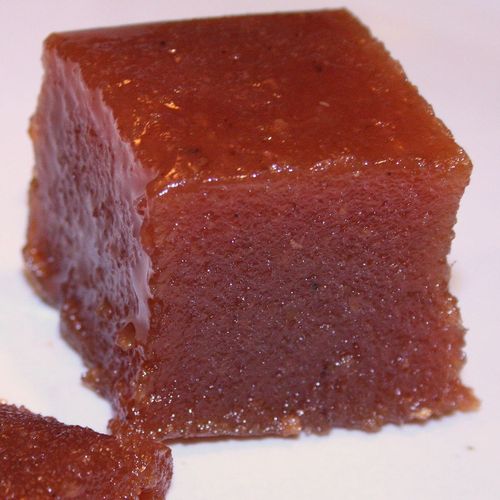 Dulces membrillo via Wikipedia commons
Dulces membrillo via Wikipedia commons
From the Spanish by way of Portugal, Dulce de membrillo is made of quince fruit, sugar and water, cooked over a slow fire. It is sweet and mildly tart, and similar in consistency, flavor and use to guava cheese or guava paste. It is sold in squares or blocks, then cut into thin slices and spread over toasted bread or sandwiches, plain or with cheese, often served for breakfast or as a snack, with manchego cheese or mató cheese. It is very often used to stuff pastries.
Empanadas dulces / empanaditas
Hand pies stuffed with all manner of sweet fillings are a common sight in New Mexico. Typical fillings include dates, apples, peaches, or quince. They can be small or quite large.
Flan
You know flan: a decadent cooked caramel cream custard which is popular in a variety of cultures. Perhaps owing to the combination of dairy production and Mexican and Spanish influence in the state, flan is extremely popular in New Mexico. It's as standard on dessert menus as chocolate cake.
Fry Bread
Also called Navajo fry bread, this is a staple that comes with a sad story. After being ousted from their land, Native Americans had to make due with what they had. Government supplies of staples were often rancid; making due with the minimal ingredients they had, fry bread was born. It has become a sacred tradition, and some say “it is to be consumed by the people until the earth has again become purified.”
Horchata
You'll see your fair share of horchata in New Mexico. This beverage made from soaked ground rice comes across as “milky” but it’s typically not made with actual dairy. It’s typically sweetened with sugar and scented with cinnamon. It’s a common street vendor beverage and is a common beverage offering at restaurants in New Mexico.
Hot chocolate
Sure, you can find the Starbucks or Swiss Miss types of hot chocolate in New Mexico. But you can also find a more exotic and luxuriant Mexican/Spanish style of drinking chocolate. According to cuisine expert Gwyneth Doland, “Both hot chocolate and atole are traditional accompaniments to tamales. Mexican hot chocolate is far, far superior to the American version. First, they make it from real chocolate. Then, they spice it up with canela, vanilla and sometimes a kick of chile. If you can’t find ancho chile powder, try regular old red chile powder; just don’t use a powder that contains anything except ground chile peppers.”
Jamincillo
Have you ever heard of milk fudge? Or perhaps penuche? If so, you have an idea of what jamincillo is; if not, let me explain. It’s made with milk, sugar, butter, vanilla, and pecans. The first four ingredients are heated and lightly caramelized; once they reach a level of firmness, they are either rolled or pressed into a pan to form confections.
Marquesote
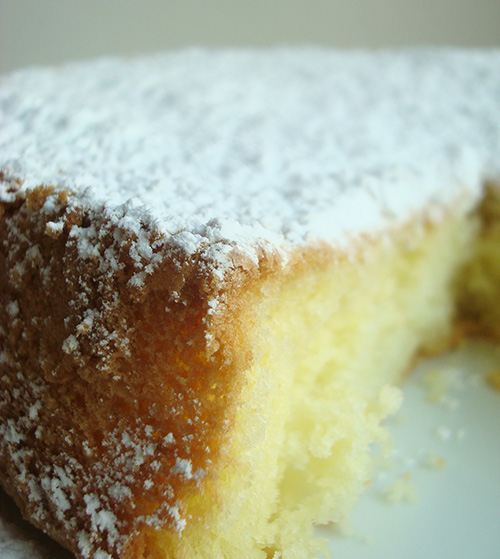
This is a simple and classic sweet in Mexican and Salvadorean traditions. Made with yeast, it’s sweeter than a typical bread, and with a more delicate crumb owing to cornstarch, but less sweet than a cake (so it is often called “Mexican cake bread” which seems to tell it like it is). It can be served simply, with confectioners’ sugar as a breakfast item, or gussied up with fruit or syrups. You'll often see variations on this type of cake bread in the panaderias which are so common in New Mexico.
Mexican wedding cakes
They exist under many names and in many different cultures: Russian teacakes, snowballs, kourabiedes, Armenian sugar cookies.
They’re extremely popular in New Mexico; bakeries and restaurants always seem to stock them. Variations will include Bocaditos de miel de abeja (honey drops) and yemas de nueces (nuts and yolks, referring to some key ingredients).
Molletes
Molletes are better known as a sort of open faced breakfast sandwich, but there is a lesser-known dessert version. Sometimes referred to as molletes de coco, these are sweet buns filled with a sweet mixture, usually a creamy custard. They can be appointed and garnished with rum, coconut, icing, and pumpkin seeds.
Natillas
In my opinion, the best way to describe natillas is to call it “rice pudding, but without the rice.” It is a relative to the French îlles flottantes, or floating islands. Cooked on the stovetop, natillas have more milk and fewer eggs than their French cousin, which makes it thinner and creamier.
Paletas
To call paletas “ice pops” would be a disservice and an understatement. Far from the frozen sugar water sticks of color, paletas are rich in flavor, made with fresh juices. They’re extremely vibrant both color and flavor-wise. They’re a popular item in the summer in New Mexico.
Panaderia fare
Conchas, pan de huevo, marranitos, bigotes: all of your favorite pan dulce favorites from Mexican panaderias can easily be found in New Mexico.
Panocha
Panocha is a pudding made from ground sprouted wheat and piloncillo. It is traditionally eaten during Lent. The sprouted-wheat flour itself is called "panocha flour". But listen to me right now. Do not google images for it, because you'll learn that it's also slang for something else.
Pastellitas Indios
Almost like a garibaldi biscuit, this pastry is like a pie that has been flattened on purpose: it has dried fruit condensed to a sticky-sweet filling between flat pastry crust. It's way better than it sounds.
Sopaipilla
A signature New Mexican treat, this is not necessarily sweet. Literally “little pillow”, this fried bread is typically served with honey, which is why I give it honorary sweet status. It’s served alongside savory meals, though, but I consider it sort of like a sweet respite during a savory meal.
Tamales
True, they’re more famous for being a savory dish, especially popular around the holidays. But here's a secret: give them a sweet filling and they’re a dessert! You’ll find fruit-filled varieties throughout the state, with fillings ranging from cheese to fruits.
A particularly interesting variety of tamale is called kneeldown bread. Also called Navajo tamales, this is a sort of sweet tamale, but don’t be misled by the name. Made from corn, fat, and water, it derives its sweetness naturally, from corn, but is baked hard, like a cracker, and sometimes stored all winter long. It’s named for the prone position assumed to make it.
Tres Leches Cake
Literally “three milks”, this cake is beloved all over, but has a strong presence in New Mexico--along with flan, it's as ubiquitous as chocolate cake on dessert menus. The style can vary, but if you ask me, a good one is made with a spongey cake to absorb all of the milk, and is so saturated that it almost sops a bit when cut into.
Pastry profiles
A sampling of regionally famous and interesting desserts I've sampled or heard about from trusted sources in New Mexico. I believe that these desserts are unique in that they all offer a distinct sense of place while you're in the Land of Enchantment.
Atole Piñon Pancakes, Tecolote Cafe, Santa Fe
Though the restaurant is closed for the moment (they lost their lease and are looking for a new spot), their pancakes are legendary. As wide as a salad plate and satisfyingly thick, one pancake really will do. It’s flecked with plenty of blue corn and studded with piñon.
Apple Pie with Green Chile and piñon, Daily Pie Cafe, Pie Town
This is probably the most famous pie in New Mexico, as it is the only one I can think of which has been featured in the Smithsonian. A thick double crust plays house to spicy apple slices flecked with green chile and pinon.
Blue Corn Doughnuts, Whoos Donuts, Santa Fe
Picture a cake doughnut. Now, change everything: make it with blue corn to give it an ever so slightly gritty texture and nutty flavor, and top it with a sticky sweet raspberry jam spiced with a whisper, not a shout, of jalapeno. It sounds a bit much but truly, it’s a thing of delicious beauty.
Caramel Pinon Ice Cream, Taos Cow, Taos
If you like dulce de leche ice cream, chances are you’ll love this creamy, mellow yet sophisticated flavor. Caramel ice cream gets a rich expansion of flavor thanks to a smattering of pinon nuts, which round out the flavor and make it more interesting.
Chocolate Pecan Pie, Cafe Pasqual’s
Pecan pie is great, but like a great many things, it is improved by chocolate. The name may not insinuate its greatness, but one taste of this sweet and flavor-filled pie will make you a believer. It’s a beloved dessert at a beloved restaurant.
Custard empanadas, Leo’s Bakery, Las Cruces
Fruit empanadas are one thing. But fruit and custard? Amazing! The custard empanadas are a popular and interesting item to try at Leo's Bakery in Las Cruces.
Eclairs, Charlie’s Spic N Span Cafe, Las Vegas
A giant cream puff sign will put you in a pastry mood even before you walk in the door, but the eclairs are what keep the crowds coming. Technically, these are not eclairs, but large, elongated cream puffs with chocolate icing...but really, who’s complaining?
Fruit filled burritos, Michael’s Kitchen, Taos
Pretty much exactly what it sounds like. But sweet, not savory.
Ice cream sundaes from Vanilla Moose Ice Cream, Aztec
To call the owner of Vanilla Moose “zany” would be an understatement. She concocts a mile-long list of mini sundaes with any number of toppings from pretzels to pineapple upside down cake, and serves them with a smile. Free mini cones for babies and dogs.
New Mexican wedding cake, Mary and Tito’s, Albuquerque
I know I just spent all this time explaining that Mexican wedding cakes are actually cookies, but this exceptional cake happens to have almost the same name as the cookie but actually be a cake. Confused? Don't be. Focus on the cake, which is really quite incredible. I'd describe it as being like hummingbird cake, but without the bananas.
Peanut mexican wedding cakes, Glenn’s Bakery, Gallup
Typically, mexican wedding cakes are made with almonds or pecans, but this interesting version makes use of New Mexico's peanut bounty. Not many cookies feature peanuts--they all seem to have peanut butter--but these make a case for more peanut usage in cookies.
Pinon biscochitos, El Meze restaurant, El Prado
Looking for a fancy version of the state's down-home official cookie? Look no further. Delicately flavored with pinon, the biscochitos at El Meze restaurant, owned by famed NM food historian Fred Miller, are really something else.
“Potato” ice cream, Cowgirl Cafe, Santa Fe
There’s no actual potato in this dessert, which is named for its looks rather than its flavor. Ice cream is rolled in cocoa and presented as a baked potato, down to trompe l’oeil pat of butter. It’s a favorite with children, but beloved by adults, too.
SPAT (pinon caramel truffle), Chocolatesmith, Santa Fe
Named for the shoe covers favored by turn-of-the-century dandies (I don't really see the resemblance but I can let it go), these chocolates are rich in caramel and slightly salty pinon. They're a unique treat at a purveyor which features many New Mexican ingredients in their delicious chocolates.
Tres leches cake, The Pantry Restaurant, Santa Fe
The Pantry restaurant is famous for breakfast in Santa Fe, but here's a little known fact: one of the employees' wives makes their tres leches cake in small batches at home and supplies the restaurant. This cake tastes like love, and oozes milky goodness when the tines of your fork hit the cake.
Lore and interesting bits from New Mexico
The curious case of the biscochito
Pretty much everyone I've emailed or spoken to spells the state cookie "biscochito". But we're all doing it wrong: the official word is that it's "Bizcochito". As I learned here,
In 1989 New Mexico House Bill 406 declared the bizcochito as New Mexico's Official State Cookie. The battle over the state cookie was not about adopting it but how to spell it. Several lawmakers got on the House floor to press for the "s" or"z". Eventually the Senate returned it as "bizcochito". To this day the Senate version prevails, but as we all know, it's the taste that gives a biscochito the name, no matter how you wish to say it.
Pastry Pilgrimage: Pie Town
Pie Town is located in a relatively remote part of southern New Mexico, and is very much the small frontier town. When I went there, I was told jokingly that its name is inspired by the fact that the town is "exactly 3.14 miles from the middle of nowhere."
As the legend goes, the town gets its name from an enterprising local who began to sell sundries and snacks, notably pies, to travelers passing through. Without much else to discern the town, it began to be referred to as "Pie Town". The name caught on, and has held strong.
Interestingly, pie has not been a constant in the town that bears its name. There have been long stretches when no pies, or worse, not very good pies, have been sold.
Today, two of the small handful of retail businesses in Pie Town are pie related: the Good Pie Cafe and the Pie-O-Neer. The former is only open seasonally, so you'll have to wait until spring to sample their pies; as the Pie-O-Neer advises, "our days and hours change like the weather"—that is to say, call ahead if you're planning a trip to try them out.
A recipe for the road
It would be inhuman to close without at least one recipe, right? So here's a recipe for some biscochitos!
Pinon Biscochitos - from Fred and Annette of El Meze Restaurant
Ingredients
- 1 cup butter; softened
- ½ cup shortening
- 1 cup sugar
- 2 tsp anise seed; finely ground
- 2 eggs
- 4 cups flour
- 2 tsp baking powder
- 2 tsp baking soda
- 2 cups pinon nuts; finely ground
- ½ tsp salt
- ¼ cup water
Directions
- Preheat over to 375 degrees.
- Cream butter and shortening together with mixer or in food processor. Add sugar and anise seed and blend until mixture is light and fluffy. Beat in eggs, one at a time.
- Mix flour, baking soda, ground nuts and salt together. Add flour mixture to butter mixture and mix until smooth.
- Add enough water to form a stiff cookie dough. Chill dough for 1 hour or longer.
- Cut chilled dough into 6 pieces (keeping pieces in the refrigerator until ready to use). On floured surface, roll out cookie dough until 1/8” thick. Cut out with 1-1/2” round cookie cutter. Press pinon nuts on top of each cookie. Sprinkle heavy with raw sugar.
- Bake in oven for 10 minutes. Cookies need to soft brown color, not white.
Well, that was a totally sweet tour of New Mexico sweets, sweeties! If you have anything to add or thing I got something wrong, please feel free to chime in to make this guide even better!


